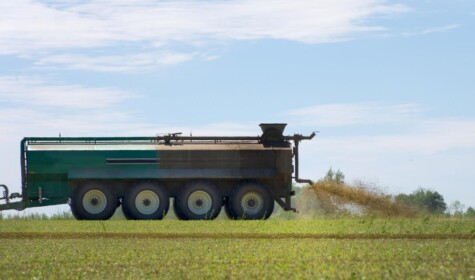Using human urine and faeces as fertiliser may seem an unappetising concept but it’s been common practice for centuries. In the sewage systems of today, which deal with millions of tonnes of domestic waste and industrial effluent, this human fertiliser comes in the form of treated sewage sludge.
Promoting a waste product that some consider hazardous as a resource to grow your food may seem like a paradox, but in Britain, a world leader in recycling sewage into agriculture, it is recognised by the government and the EU as the best environmental option. It diverts waste away from oceans and landfill and provides essential plant nutrients to the soil. Nevertheless, EU organic regulations don’t permit the use of sewage sludge on organic farms. So, what are their concerns? Is this form of manure safe for agriculture? Are we putting our health and our soils at risk when we spread human waste on land?
“1% of wastewater is waste. The rest is wasted water.”
Human urine and faecal matter are a rich source of essential plant nutrients. Historically, human excreta, ‘nightsoils’, were collected from towns and villages and spread in raw or composted form on fields in the surrounding farmland. This informal treatment is still practiced in some areas of China, South East Asia, Africa and Latin America, where municipal sewage works don’t exist or are poorly functioning. In the 1850s, Europe’s growing urban populations and the discovery of the link between raw sewage and cholera led to the implementation of large-scale sewage systems. These water-based systems combined all domestic waste, industrial effluent and road surface run-off. For the next century the resulting sewage sludge was disposed of in landfill and directly into the oceans. Eventually, in the 1970s, growing awareness of the environmental impact of sewage on aquatic life led to widespread bans on ocean dumping across the developed world. Since then, research, technology and regulation of wastewater management have progressed to a high standard.
In Britain, sewage sludge goes through a tertiary anaerobic digestion process that kills off up to 99.99% of pathogens. The treated sewage sludge this produces is referred to as ‘biosolids’ and most commonly comes in the form of dried cake digestate.
Matt Taylor is an environmental scientist and consultant at ADAS, Britain’s largest independent provider of environmental solutions, services and consultancy on recycling materials to land. He says that “the most common outlet for biosolids is agricultural recycling. Around 1 million tonnes of dry solids (that’s equivalent to 3.5 million tonnes of fresh solids) were used as fertiliser [in Britain] in 2013.”
Biosolids can increase agricultural yields and improve soil condition. They provide nitrogen, phosphorous and potassium in a less soluble form than farmyard manure and artificial fertilisers, which means they remain in the soil for longer and are less prone to leaching into groundwater or run-off, which pollutes waterways. Biosolids also contain useful levels of sulphur and magnesium and trace levels of micronutrients. Unlike artificial fertilisers, biosolids contain 20%–80% organic matter, which is critical for the health of soils.
Could biosolids replace our reliance on artificial fertilisers?
Manufacturing fertilisers requires fossil fuels, so as the price of fuel increases this has a knock-on effect for the price of artificial fertilisers, food production and ultimately the price of food. Our reliance on mined phosphorous is a major concern. The extraction of phosphate rock is not only a very toxic and energy intensive process but it’s also a non-renewable resource that’s predicted to reach peak supply in 2033. After that the price of phosphorus will increase significantly, bringing the price of food up with it. According to the Soil Association’s peak phosphate report, without mined phosphate, crop yields in conventional farming could be reduced by half.
On a global scale we could be recovering much more phosphorus from human waste. It’s estimated that only 10% of the phosphate lost from human excreta is recycled back to the land due to inefficiencies in wastewater treatment or the absence of wastewater treatment altogether. Results from a 2009 study in Chemosphere suggest that, if properly collected, the phosphorus available from urine and faeces could account for 22% of the total global phosphorus demand.
Already in Britain we recycle 77% of our sewage onto agricultural land. Could biosolids eventually replace the need for artificial inputs?
According to Taylor, “biosolids can play a role but it’s not going to replace other forms of fertiliser. We could do more but we are using the vast majority of sewage sludge already.” However, with improved technology we could extract more nutrients. “We’re getting more phosphorous out of waters in the form of struvite. This is a mineral build up on pipes, which causes blockages in pipelines. Thameswater has started harvesting this struvite as it contains phosphorous.”
Wastewater treatment is improving all the time in Britain as regulations become more stringent and require treatment plants to remove more nitrogen and phosphorous from sewage. As a result the volume of biosolids produced is increasing every year, making more fertiliser available for agriculture.
But is it safe?
There are understandable concerns from farmers, consumers and food retailers about pathogens, heavy metals, pharmaceuticals and other hazardous organic chemicals in sewage sludge. The good news is that biosolids are the most researched and well regulated of organic materials applied to land in Britain and the framework for regulating sewage sludge is more stringent than that of farmyard manures. Numerous pieces of legislation and best practice guidelines, like the Safe Sludge Matrix, must be adhered to by everyone involved in the treatment and use of sewage sludge.
Heavy metals are the main concern. These are strictly monitored, however, and regular testing shows that the levels of heavy metals in soils fertilised with biosolids are significantly below the maximum permissible levels. In fact the levels are so low now that the Soil Association has recommended the European Commission lifts the ban on using biosolids in organic farming. The Soil Association still recognises that the existence of other potential contaminants from organic compounds, such as GMOs and pharmaceuticals, need to be considered.
But there’s still a big question mark hanging over the impact of industrial chemicals and personal care products in domestic waste as well as the huge amounts of medicines that pass through the human system. Whilst the vast majority of these are biologically degraded in the treatment process, trace levels of some persist.
WaterUK, a member organisation of the water utilities, states “there are no reported cases of human, animal or crop contamination due to the use of sludge on agricultural soils.” Yet studies have found the artificial hormones used in birth control pills affect the endocrine systems of fish exposed to sewage effluent water, which affects fish fertility. There’s concern about how this would affect livestock that graze on grassland treated with sludge. Despite the lack of scientific evidence to prove long-lasting damage, there is also not enough evidence to prove it’s 100% safe either.
Sanitation fit for the future
The risk of chemical contaminants and pharmaceuticals could be reduced by preventing human waste from mixing with all other domestic and industrial waste in the first place. Ecological sanitation systems are starting to come into use all over the world that separate human excreta from other waste streams. Ecological sanitation (ES) includes urine diverting toilets, high-tech vacuum systems and composting toilets. These inexpensive systems can be used in various contexts from small villages to large municipalities. ES separates greywater, human faeces and urine and stores them in underground tanks.
A great advantage of ES is this separation. The majority of nutrients in human excreta are in urine – if uncontaminated by faeces it’s relatively sterile and can easily be used on crops with little treatment. This low-cost solution makes most sense in rural areas where houses are not connected to centralised sewage systems or in close proximity to agricultural land.
It’s harder to justify the cost of retrofitting ES into existing centralised sewage systems that already supply safe drinking water and recycle waste to a sufficient level. WaterUK estimates the total value of nutrients in biosolids recycled to agricultural land in Britain at £40–£50 million per annum. The value of preserving life in our oceans, the health of our soils and the quality of our water is priceless, and as water and energy become more scarce and costly, and phosphorous reserves run out, ES could become a much more attractive and cost-effective prospect.
According to the UN 90% of wastewater in the developing world is expelled, untreated, into the oceans. Whilst rich countries have had the finances and governance to manage sewage effectively, there’s still a long way to go in making this universal. How will we, as a global community achieve it? Perhaps that will give you something to ponder when you’re next on the toilet.



